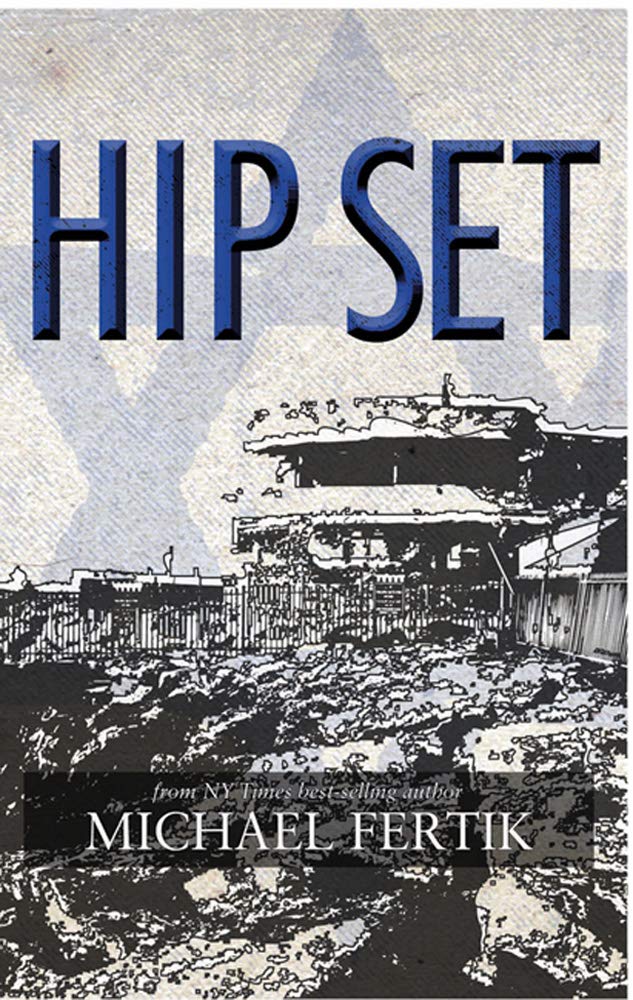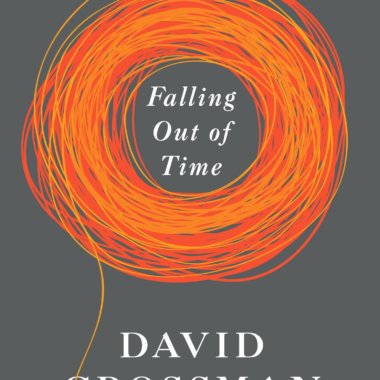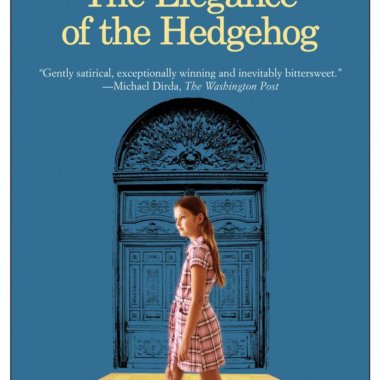When it comes to human behavior, there is nothing pure about it, just as there is nothing pure about what lies on an arc between good and bad or between heaven and hell. Michael Fertik’s novel Hip Set scours human behavior in all its dimensions and disguises, whether the behavior tilts toward the sacred or toward the profane. Usually, it—human behavior—settles in the secular world, until the mythic intervenes and tantalizes with its own riches.
Fertik is much too disciplined an author to deal in stereotypes in Hip Set: His characters project the verisimilitude of those persons who live in the secular world and aspire to the sacred, as well as those who live in the secular world and sink to the profane. In the opening chapter, readers are introduced to the protagonist Oscar Orleans, a Congolese refugee, but it isn’t until six chapters later that we get a view of the antagonist Ruben Dumanovsky, an alleged Russian immigrant. Getting to know both of them is a deep dive into the worlds of religion, immigration, myth, and murder.
OSCAR ORLEANS
When the story opens, Oscar Orleans is nearly forty years old, a refugee from Kinshasa who converted to Judaism after he arrived in Israel twenty years before. He aspires to be a devoted Jew, reciting the Shehecheyanu, the Jewish prayer, and feels blessed to be living in Israel “and not in Congo or Sudan or Yemen or Saudi or Zimbabwe or any of the other places he might have been, could have been, but for the grace of a loving G—d.”
He still has night terrors twenty years after he made his way north, reliving in traumatic detail the day Colonel Roland DuBest escorted him to “a morgue, the National Forensic Processing Bureau in Kinshasa, to identify the body of his best friend Arthur.” Both Arthur and Oscar were members of the University Freedom Alliance—Oscar was chair—and as students, convenient targets of the government. Seeing the extent of Arthur’s head wounds and his all-body hemorrhaging, Oscar realized he was next. The next morning he fled Kinshasa and traveled overland, eventually finding safety in Israel. Even years later, he has flashbacks of his friend seized, tortured, and dead.
For Oscar, the fear about being next never goes away: As a stateless black man, he knows that “no matter how much or how often he wanted to distinguish himself from the refugees he helped on a daily basis – his education, his outlook, his . . . everything, he felt – he had to admit sometimes that he was, after all, just like them: a man who had suffered terrible displacement.”
It would have helped if his asylum petition had already been processed and approved sometime during the twenty years he’s lived in Israel, but it is still hung up in a bureaucratic snafu: Is his asylum petition even valid now that he’s seeking permanent residency? Nevertheless, his attorney Tamar Ben Artzi continues to meet with him, sign his papers, and submit them to the Population and Immigration Authority. Maybe he would know in six months, in spite of the fact he has been the police liaison to the Sudanese refugee community for the last decade, working alongside Inspector Mefake’ah Kobi Sambinsky, head of the Asylum Unit of the Israel Police, Tel Aviv District.
Oscar Orleans doesn’t miss the irony that even his important work with Kobi doesn’t count toward permanent residency any more than Tamar Ben Artzi’s lawyerly effort toward asylum convinces the immigration authorities. Although he is the go-between for Kobi’s Asylum Unit and the refugee community, he has no official ID. No badge. No business card. No email address. No status. He is escorted to his second-floor, semi-official desk, which he rarely uses. He has no authority, period.
Does Oscar Orleans hold a grudge? He sits at La Mer beach bar at his usual time—4:00 p.m.— drinking his Americano—the only item he orders—and savors his blessed good fortune to be a part of this country, Israel: “He looked at the sea, smiled, felt the sun on his face, and marveled at how unlikely his existence – this existence – was. He nearly felt moved to say the Shehecheyanu, but he decided against it, lest he accidentally debase the prayer from overuse.”
Oscar commits himself to Judaism, to Israel, his only home since he left Congo, and in this commitment lies an aspiration that moves him further from the middle of the arc that bends toward the sacred, as much as any man can in a secular world. His decency lies in his formality, in diction and dress, but more so in the depth of his conviction that he is blessed to have found a home where he can help other refugees who have experienced, like him, violence and terrible displacement. For Oscar, his formality “was mixed with an acute awareness that, no matter what anyone said or thought they thought, every single time he appeared anywhere in this country, he was carrying the entire continent of Africa on his shoulders and the aspirations of every single refugee. To dress well was to move his two worlds one centimeter closer together.”
MICHAEL ALOU KUUR KUUR
Oscar’s decency counts for a lot on the Shabbat morning he and Kobi Sambinsky meet at the Dolphinarium, a shipwrecked building in an otherwise built-up Tel Aviv, to investigate the murder of a male in his late teens—maybe twenty—over 6’2”, shot in the stomach and the head. Using a pen to lift the murdered victim’s football shirt, Oscar shows Kobi twenty rows of healed wounds on his chest and belly, a tribal scarification, that Oscar identifies as a ritual of the Toposa tribe in Southeast Sudan. Thus begins the detective story that Kobi Sambinsky, Oscar Orleans, and Officer Angelika Cone solve, but not without the critical help of Michael Alou Kuur Kuur, known in the Sudanese community as Pastor Michael.
Oscar and Pastor Michael, of the Dinka tribe, are displaced refugees, both adhering to a formality that each respects in the other, though Oscar knows little about Kuur’s private life, until Kuur is pulled into the investigation against his will and his safety. It becomes increasingly apparent to Kobi and Oscar that Kuur knows more, much much more, about the mystery surrounding the Dolphinarium victim. He proffers just enough information to help the detectives form a hypothesis concerning the murder of the teenager, but in the end Kuur doesn’t withhold the vital information that adds to, reinterprets, and otherwise upends the detective team’s induction, deduction, and speculation. They need Kuur to help them. Suffice it to say that Kuur’s revelations lead to Ruben Dumanovsky, the alleged Russian immigrant who professes his Jewish heritage and wears a yarmulke proudly. He is also a liar who hoodwinked the immigration authorities.
RUBEN DUMANOVSKY
Thanks to Fertik’s clues that foreshadow Dumanovsky’s culpability, readers can assess this man’s behavior as bending the arc toward the profane, reaching the outermost point of human poison: murder. Dumanovsky owns “Pasternak Design Build Develop” in “Little Russia,” a front perhaps of his construction business, but the criminality he executes in his thirties doesn’t favor human redemption: hook up with a man from Sudan while the country is in the throes of a civil war, build your corrupt business through him, and betray him while the country disintegrates.
Dumanovksy is not a stereotype; he is given his human due, although his particular branch of humanity involves finding hidden riches, murdering those who inhibit his finding these riches, and beating up those who know more about these riches than he wants the Israeli Police, Tel Aviv District, to know. Oscar Orleans sizes him up upon meeting him for the first time: He “was aware that this interlude was probably common to all encounters with gangsters: the home team and the visitors were instantly gauging who would win in unannounced mortal combat. It was ridiculous and frightening.” Oscar Orleans hates the violence written all over this man. The irony is there for readers to witness: Dumanovsky traded his education in civil engineering for thuggery and murder to seek riches lying dormant in a myth.
Hip Set
About three-quarters into Hip Set, the narrator invites readers into the world of ancient times, and Kuur’s sublime rendering of the myth of the Queen of Sheba converges with Oscar and Kobi’s fact-based detective work. It shouldn’t be too surprising that the detectives haven’t put the whole puzzle together, partly because Kuur hasn’t been completely forthcoming, and partly because important pieces are still shrouded in mystery.
Here, then, is a snapshot of the myth of the Queen of Sheba as narrated by Kuur.
The Queen of Sheba, who “ruled over a vast stretch of the arc that describes the tracts west of the Nile River to the reaches east of Yemen,” visited Israel and fell in love with King Solomon. The Queen brought sumptuous riches with her—pure gold, jewels, spice, silk, and precious wood—but it was the gold mined from what is today South Sudan by the ancestors of the Toposa people that made the most breathtaking creations. In particular, there was “a kind of layered chain mail, all gold . . . of long, threaded strands, woven together like silk and spider webs,” and “matched [the Queen’s] person so perfectly, that it was said to make the sound of starlight as she walked like a cat around her throne room.” This was the gold chain the Queen wore around her hips when she and Solomon consummated their passion.
Upon leaving King Solomon but determined she would return to Israel, she instructed her goldsmiths to bury a portion of her own treasure in a cave “in the desert cliffs near the Dead Sea,” including her prized hip chain. For millennia the Toposa tribe had kept the location of her treasure secret, but the myth still lingered about her gold chain mail, “the greatest jewel and most powerful symbol of romantic and national seduction ever created.”
Kuur offers his audience more detail than this snapshot offers, but if revealed in this review, it would surrender the last intrigue and thrill in the novel. Still, two significant details can be exposed, as they are in the quotes above: the Queen of Sheba’s hidden treasure in the desert cliffs near the Dead Sea, and the prized gold chain mail. Both play a significant role in Hip Set in two ways. First, the hidden treasure begins a chain of events that devolves into human behavior tilting toward the profane. Second, the Queen’s gold chain mail surfaces as a motif in Hip Set: After twenty years, Oscar Orleans decides that he has come to Israel “so that he might discover and sing the praises of the Israeli female hip set.” Like the Queen who wears on her hips the solid gold chain and walks “like a cat around her throne room”— a slow movement, a fluid grace—so it is with the Israeli hip set: “the casual, forward-pressing, urgent swing.”
Thus, the prized hip chain of ancient times lives in modern Israel for Oscar Orleans, a reminiscence of the swing, the sound of starlight, the beauty of the gold chain mail, “seamless cords of identical loops, hooping into one another like symbols of infinity.”
A SEQUEL
Michael Fertik, creator of this incredibly rich detective thriller, doesn’t leave Oscar Orleans without the reward he has been seeking for twenty years. He is much too in tune with his protagonist’s character to fail him. In the last scene in Hip Set, Kobi Sambinsky promises Oscar Orleans that he will help Oscar with his asylum petition. Kobi figured justice would take its course, but it didn’t, and now he will help Oscar become a person of state.
Oscar Orleans is a character sure to show up in a sequel of Hip Set, along with Kobi, Kuur, Kuur’s wife Lily, and Cone. Dumanovsky will be left behind. But, maybe not.



